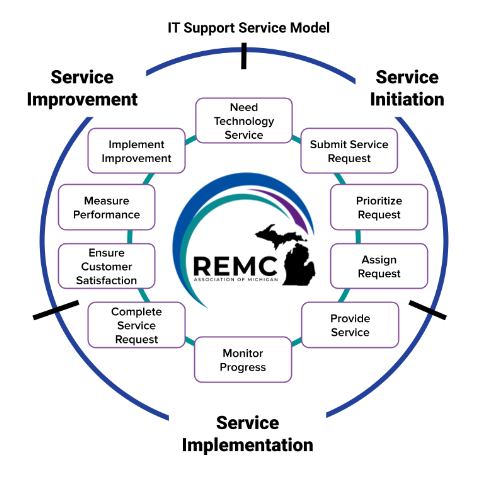1 Introduction to IT Support Service Model
Basics
Information Technology (IT) Service Management (ITSM) is the implementation and management of the quality of IT services in order to meet the technology needs of your school system. The objective of ITSM is to deliver value to all of the adults and students in the school system through the range of technology services provided by the IT Department. Service management is a highly specialized combination of processes that include defining, documenting, agreeing, monitoring, measuring, reporting, and reviewing the levels of service provided. A combination of all the processes used to support the service management support center framework is referred to as the service lifecycle and can be summarized in a Service Model. Think of this lifecycle as being a series of steps that help guide the completion of technology service from beginning to end.
Terms to Know
You should know the following terms:
- Information Technology (IT) Service Management (ITSM)
- Service management
- Service lifecycle
- Standard operating procedures (SOP)
- Service Model
- Service Initiation
- Service Implementation
- Service Improvement
Information
Many businesses and industries around the world use standard operating procedures (SOP) to guide their work. The same is true for IT Departments. You likely have SOP that cover resource procurement and management, network operations, managing communications systems, help desk or customer service, website and social media management--anything your department is responsible for. Knowing and using these procedures improves how well staff in these departments do their jobs. The standard operating procedures in most IT Departments center around a Service Model. A Service Model is a series of steps that you and others in the IT Department follow to make decisions about what to do, who does that work, when and how to do it, and how well you have completed your work. Hopefully, the Service Model your IT Department has adopted follows industry-standard guidelines for Information Technology (IT) Service Management (ITSM).
The Service Model can help everyone in the IT Department do a better job, because it helps each staff member understand what to do in every step along the service lifecycle. Some of the benefits of following a Service Model include:
- Taking the guesswork out of what staff are expected to know and do;
- Reducing errors that might be made when addressing technology service requests;
- Making it easier to provide customer support;
- Improving teamwork;
- Increasing satisfaction and positive interactions with customers;
- Improving communication between staff and with customers; and
- Providing a framework for standardized training for IT staff.
This toolkit uses a generic Service Model developed by Frankie Jackson for Advanced Learning Partnerships using the NIST Performance Excellence program, ITIL, and other continuous improvement methodologies. Frankie has more than 25 years serving as a K-12 CTO and continues to work as an IT consultant and program developer at the national level with the Consortium for School Networking (CoSN) and others.
This generic model is presented in three phases: 1) Service Initiation, 2) Service Implementation, and 3) Service Improvement. The model is a guide and is based on a cycle of continuous improvement.. Throughout the implementation of the steps of the model, data is generated that can then be reviewed to determine how well the IT Department is meeting its charge and may also identify strategies for increasing efficiency and reducing costs.

Your IT Department may not follow the exact same model, but it should have some standard operating procedures to help anyone in the department make decisions to prioritize their work and meet expectations for quality service. If your IT Department doesn’t have standard operating procedures, there’s no better time to get started than the present!
Additional Resources
Here are additional resources you may find useful:
- National Institute of Standards and Technology (NIST) | U.S. Department of Commerce
- Consortium for School Networking (CoSN)
- Information Technology Infrastructure Library (ITIL) and Axelos
- Service Model Development using the ITIL 4 Guiding Principles by Graham Heard for ITSM Tools
Task/Self-Assessment
Complete the following task or self-assessment:
What is your IT Department’s Service Model?
It may look different than the example provided. (Hopefully it has one.) As you work through the information aligned with the steps in this one, be sure you understand what you are required to know or be able to do in each step of your adopted Service Model, or you can use this information to inform the adoption of a Service Model in your department.
